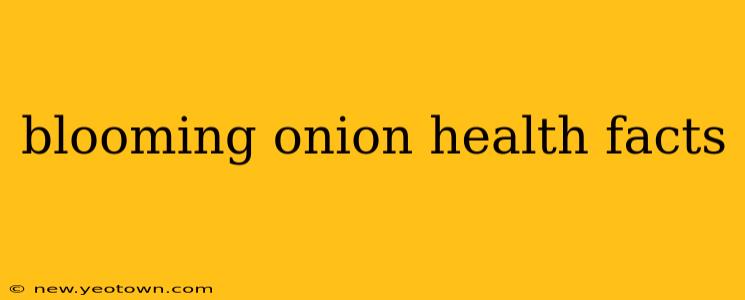The blooming onion. That crispy, gargantuan onion masterpiece, a centerpiece of many a casual dining experience. But beyond its undeniable deliciousness, what's the nutritional story behind this fried marvel? Let's peel back the layers (pun intended!) and explore the blooming onion's health facts, addressing some common questions along the way.
What are the nutritional benefits of a blooming onion?
This is where we have to be realistic. The blooming onion, in its typical restaurant preparation, isn't exactly a nutritional powerhouse. The deep frying process significantly impacts its nutritional profile. While the onion itself offers some health benefits – containing antioxidants and vitamins like Vitamin C and folate – these are largely negated by the considerable amount of added oil and potentially high sodium content from seasonings. Think of it as a treat, not a health food.
How many calories are in a blooming onion?
The calorie count for a blooming onion can vary wildly depending on the restaurant, the size of the onion, the type of batter and oil used, and even the portion size. However, you can generally expect a substantial calorie load – easily ranging from 1000 to 1500 calories or more for a single serving. This makes it a high-calorie food, contributing significantly to daily caloric intake.
Is a blooming onion bad for you?
The answer, as with most things, is "it depends." One blooming onion isn't going to ruin your health, but regular consumption as part of a diet lacking in fruits, vegetables, and whole grains isn't ideal. The high calorie and fat content, along with the potential for high sodium, could contribute to weight gain, high cholesterol, and other health problems if consumed frequently. Moderation is key. If you love blooming onions, enjoy it occasionally as a treat, rather than a regular part of your diet.
How many carbs are in a blooming onion?
The carbohydrate content of a blooming onion is also substantial, primarily due to the onion itself and any added breading or batter. Precise numbers are difficult to pinpoint without knowing the exact recipe, but expect a considerable number of grams of carbohydrates per serving.
What are the ingredients in a blooming onion?
At its core, a blooming onion is simply a large onion, sliced in a specific way to create its characteristic blooming shape. The key components determining the nutritional profile are the batter or breading (often containing flour, cornmeal, spices, and leavening agents), the type of oil used for frying (often vegetable oil), and any added seasonings (which can significantly impact sodium content).
Are there healthier alternatives to a blooming onion?
Absolutely! If you're craving a similar crunchy, flavorful experience, consider alternatives like:
- Baked onion rings: Baking instead of frying drastically reduces the fat and calorie content.
- Air-fried onion rings: Air fryers offer a crispier result than baking while using significantly less oil than deep frying.
- Roasted vegetables: Roasting various vegetables, such as broccoli, cauliflower, or Brussels sprouts, can deliver a satisfyingly crunchy texture with added nutritional benefits.
The blooming onion, while undeniably delicious, should be enjoyed in moderation. Understanding its nutritional profile allows you to make informed choices about your dietary habits. Remember, balance is key to a healthy and enjoyable lifestyle.

